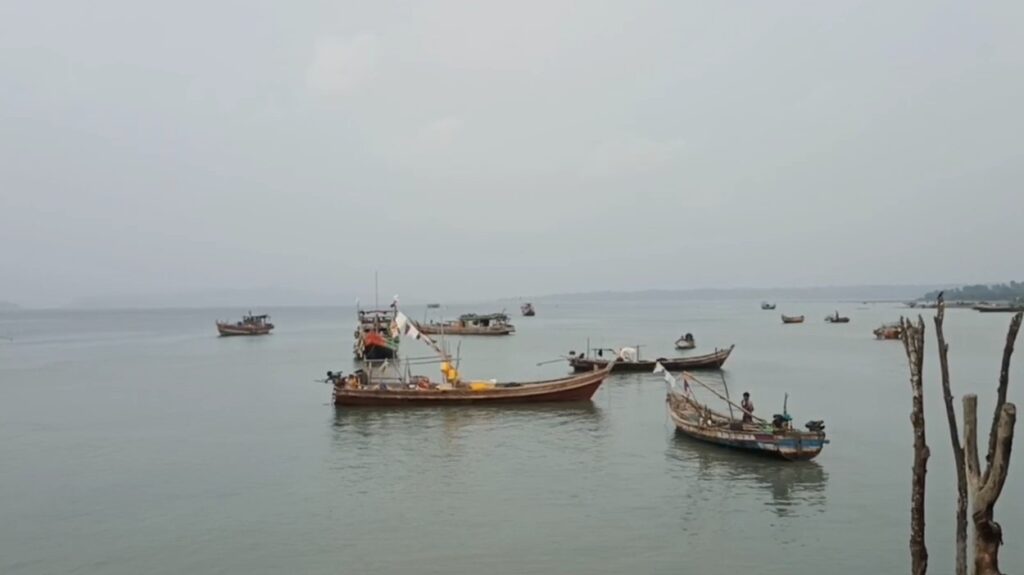It was an evening during the transitional period between the rainy season and winter.Though the rainy season had ended, the sky was still densely filled with clouds, andlight drizzle occasionally fell amidst the cool breeze.
By a banian tree near a stream, a group of people sat chatting animatedly, as ifcompeting in a lively discussion. This place, located beside the Mahine Stream in NgaMan Yae Island of Myebon Township, is a central spot for fishermen preparing to go outduring high tide.
Among them was U Kyaw Maung (alias), a 40-year-old man from Wakauk Gyi village. His dark complexion and sturdy build revealed the strength of someone who had spenthis life fishing. He was chatting with fellow fishermen while waiting for the tide to riseand head out to fish in the Paukseinkya River.
Born into a family of fishermen, U Kyaw Maung inherited the fishing trade from his ancestors. “I’ve been doing this for nearly 20 years now. It’s something I carried on as afamily legacy,” he said, adjusting his traditional longyi with determination.
U Kyaw Maung supports a family of five, including his wife and three children, entirelythrough fishing. “At home, it’s just the kids. I’ve been feeding them all with this one job.My wife doesn’t work other than taking care of household chores, so we’ve only beenliving off these two fishing nets,” he explained.
While he used to fish alone in the past, his 10-year-old son now accompanies him. “Since my eldest son doesn’t go to school anymore, I take him along. On early mornings when we need to leave, he doesn’t want to come, so I have to wake him up forcefully. When I work alone, it’s exhausting, so I bring him along to help out,” he said.

However, due to the ongoing conflicts in Rakhine State and road closures, the market for fish, shrimp, and other seafood has been disrupted. This has caused significantfinancial struggles for fishermen like U Kyaw Maung.
“In the past, we had established markets where we could sell fish and shrimp. But now, even if we catch smaller fish, there’s no one to buy them. Only large fish are in demand. With the price of fuel increasing tenfold, if we don’t catch any large fish, the day ends in a loss. Sometimes, we don’t catch anything at all for days. When that happensrepeatedly, it becomes really hard to sustain our livelihood,” he lamented.
Fish such as kakatit, ngatan, ngayant, and ngakhu are considered premium in themarket, and fishermen strive to catch these. Before November 2023, there were thriving markets in Rakhine for fish and shrimp, with some being transported from offshorecatches to inland areas. However, with road closures due to the conflict sinceNovember, these markets have completely disappeared, leading to a drop in prices for fish and shrimp.
The lack of markets has significantly impacted independent fishermen like U KyawMaung, who rely solely on fishing for their livelihood.
“In the past, we could even sell small fish at 15,000 kyats per viss, regardless of thetype of fish. Now, no one is buying small fish, and the prices are way lower,” said another fisherman, U Tin Hla (name changed), from Pikesate village in Pauk TawTownship.
Previously, a viss of shrimp sold for over 10,000 kyats, but now it has dropped to 4,000kyats. Similarly, fish that used to fetch up to 30,000 kyats per viss now sell for onlyabout 15,000 kyats.
The rising cost of diesel, now ten times higher than before, has further strainedfishermen using motorboats. “In the past, even if we didn’t catch anything, we wouldn’t feel as discouraged. Now, with fuel prices so high, not catching anything for a day is ahuge loss,” said U Aung Kyaw, another fisherman from Taline Chaung village in PaukTaw Township.

On the other hand, shrimp farmers and those involved in fish farming are facingsignificant challenges due to the high cost of diesel fuel. Business owners engaged inshrimp farming have seen their primary markets disappear, leading to a complete halt intheir operations
However, during the tide periods, water must be pumped in and out 20 to 30 times amonth. Even though the operations have ceased, laborers still need to be hired, said Daw Sandar Aye (alias), a pond owner from Lwan Lone Pike village.
“Since the pond is located a bit far from the village, each trip back and forth uses about 2 liters of fuel. Without hiring workers, it’s difficult to go every day. Shrimp prices havedropped, so we’re not even catching them anymore. But we can’t skip the water pumping, either,” she explained.
For the fishing industry, costs have significantly increased, leading to financial difficulties. While fishermen are currently allowed to fish freely in the rivers of liberated areas, the scarcity of fish has made it increasingly difficult to catch them.
In Rakhine State, fishing is a primary occupation in towns such as Kyaukphyu, Sittwe,Myebon, Pauk Taw, Thandwe, Manaung, Ramree, and Gwa. However, most local fishermen operate near the shore rather than offshore.
With rising commodity prices, fishermen are urging the authorities to lower costs to ease their struggles. The intensified fighting between the Arakan Army (AA) and the military council in areas such as Ann, Maungdaw, Gwa, and Taungup has compounded the hardships faced by people like U Kyaw Maung.
In townships controlled by the AA, the lack of communication, restricted trade, and disrupted flow of basic commodities within the region, combined with minimal cash circulation, has left many locals, including fishermen like Ko Kyaw Maung, struggling with severe livelihood challenges.
Despite the challenges, U Kyaw Maung continues to fish, hoping for better times. “We’renot even asking for roads to open or for the markets to come back during this war. But at least the commodity prices should be brought down.”
(Written by Mi Khine)




